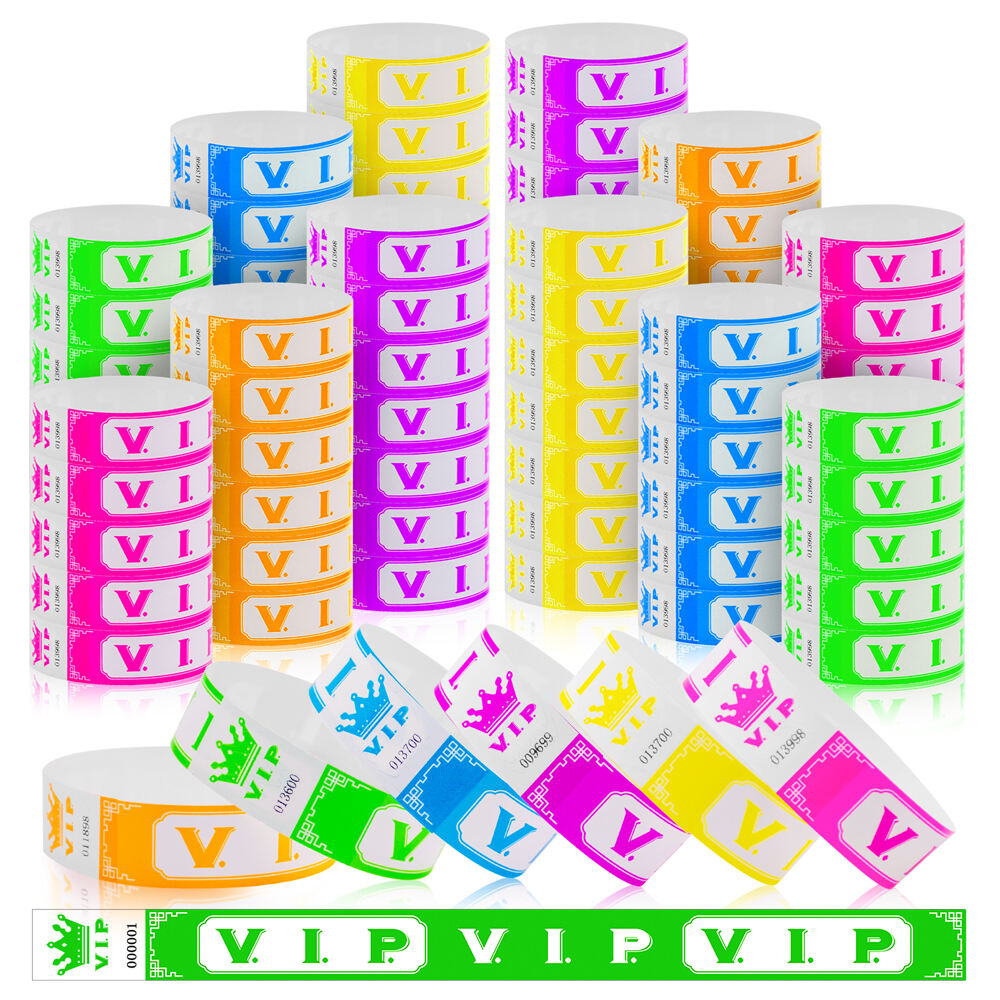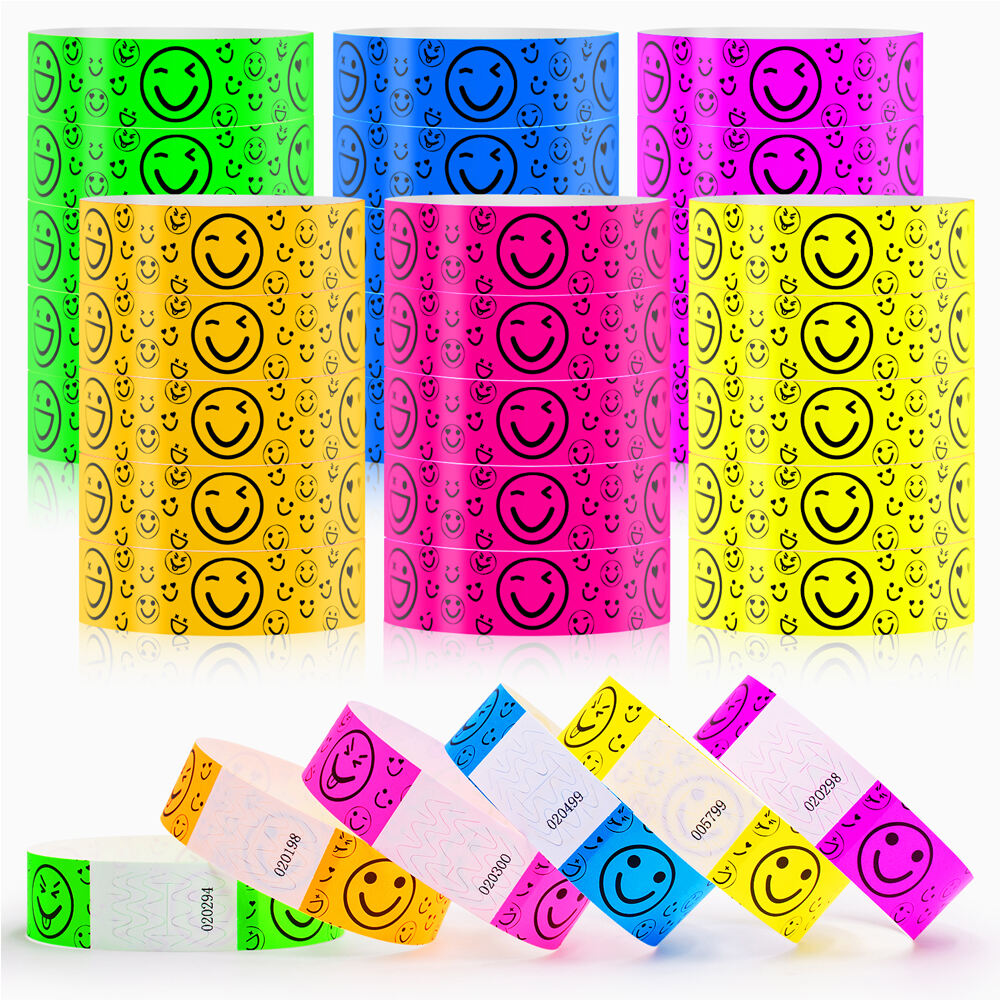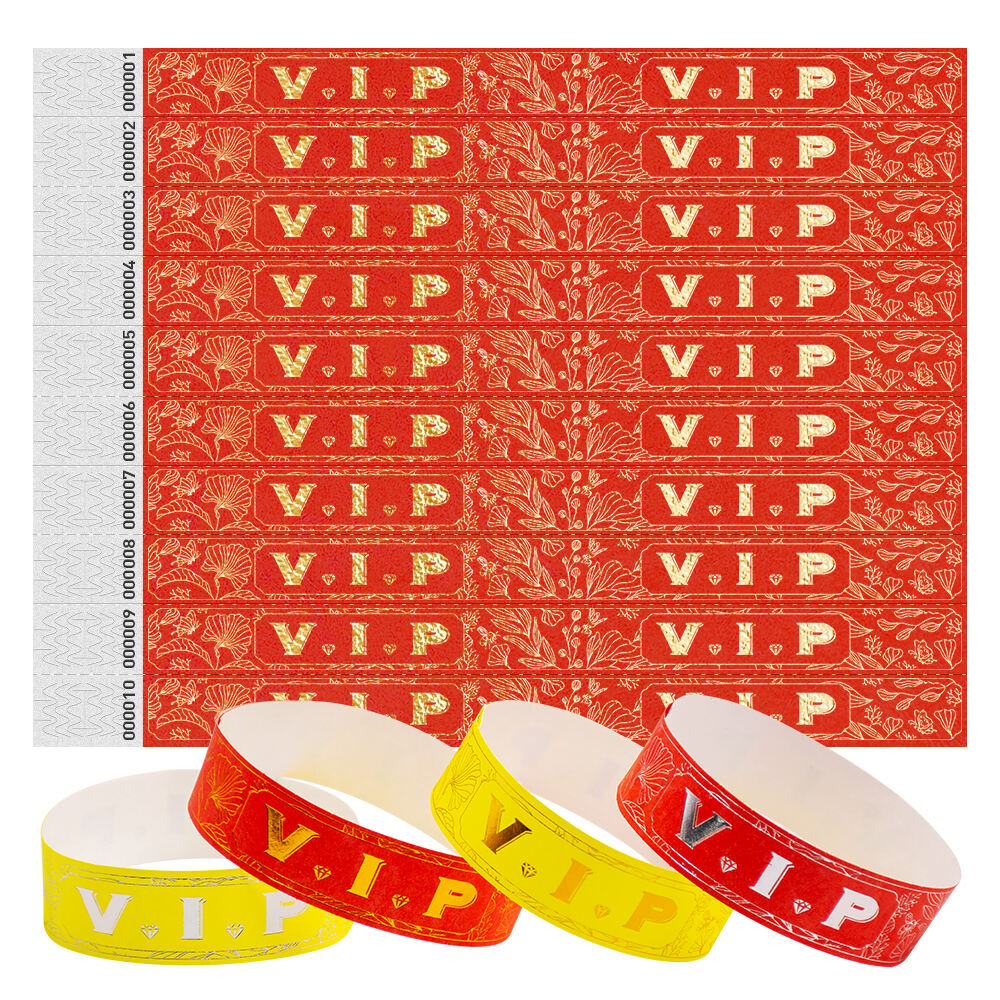Production Standards for Disposable Paper Wristbands in the Industry
Material Composition Requirements for Disposable Paper Wristbands
Tyvek Material Specifications for Durability
What makes Tyvek so special as a material for disposable wristbands? Well, it's basically high density polyethylene fibers made by DuPont, and this stuff just doesn't give up easily. The material resists tearing and keeps its shape even when things get rough out there in the elements. We did some testing back at DuPont, and found these wristbands hold up against rainstorms and heat waves without falling apart. That's why so many festivals and marathon events stick with Tyvek bands instead of cheaper alternatives. They stay put through all sorts of weather conditions, something event planners really care about when they're trying to manage thousands of attendees over several days.
Waterproof and Tear-Resistant Paper Standards
Paper wristbands need to stay intact even when soaked or subjected to rough handling at events where they're used extensively. For disposable versions, meeting certain waterproof specs matters because otherwise they just fall apart after getting wet from rain or condensation during hot summer festivals. The materials shouldn't degrade when exposed to humidity either. Most manufacturers treat the paper with special coatings or laminates that keep water out while maintaining flexibility so people can wear them comfortably all day long. Tear resistance becomes another big concern since crowds push and pull on these bands constantly. Event organizers look for products that pass ASTM D1922 tests as part of quality control. These standards measure how well materials hold up under stress, something absolutely necessary when managing large groups of attendees who might try to remove or damage their wristbands intentionally or accidentally.
Eco-Friendly Material Compliance in Production
The market for green paper wristbands is definitely growing as people become more aware of environmental issues. Many manufacturers now put sustainability at the forefront of their operations, looking for materials that actually meet proper environmental guidelines. They're turning to things like recycled paper stock and plant-based inks that break down naturally, cutting down on landfill waste quite a bit. Businesses wanting to tap into this green trend usually go after certifications like FSC certification, which basically tells customers their wood comes from responsibly managed forests. When companies do this, they're targeting those shoppers who really care about where their products come from and what impact they have. Going green isn't just good for the planet either it helps build trust with customers too, showing that a business takes its responsibility to the environment seriously rather than just talking about it.
Security Features in Paper Wristband Manufacturing
Tamper-Evident Adhesive Closure Systems
Adding tamper proof adhesive closures to paper wristbands makes a real difference when it comes to keeping events secure. These systems basically work so that once someone puts on the wristband, they cant take it off without leaving evidence. Event staff then have an easy way to spot anyone trying to sneak into areas where they don't belong. Studies suggest that good quality tamper evident wristbands cut down on fraudulent activity at events, sometimes reducing problems by around 30 percent. For people organizing big gatherings, this kind of security matters a lot because it lets them keep better track of who's actually there while building trust among regular attendees that their money isn't going to waste on fake tickets.
Serial Number Implementation for Anti-Counterfeiting
Adding unique serial numbers to those single-use paper wristbands makes them much harder to fake. Event staff can check these numbers at entry points to make sure nobody gets in with counterfeit bands. When paired with some sort of central tracking system, organizers know exactly where every band went and who actually used it. The whole setup gives venues better control over who attends what events. No more worrying about random people showing up with copied wristbands. Security teams sleep better knowing there's less chance of someone sneaking past checkpoints or causing problems because they weren't supposed to be there in the first place.
Custom Event Wristbands with Unique Identification
Paper wristbands made to order offer solid protection for events because they come with distinctive designs and markings that stop fake ones from circulating. The latest printing tech lets organizers put personalized info on each band, which makes them harder to forge and helps keep tabs on who's actually at the event. Beyond just keeping things secure, these custom bands actually make running an event easier too. Event coordinators get something flexible yet safe that fits exactly what they need for managing crowds and controlling access points without breaking a sweat.
Industry Compliance & Certification Standards
ISO 9001:2008 Quality Control Processes
When companies follow ISO 9001:2008 guidelines, they get better consistency in their production runs, especially important when making those single-use paper wristbands everyone needs at concerts and festivals. The standard shows real commitment to good manufacturing practices, and honestly makes a big difference in how reliable those wristbands actually are once they're out there. Take MoreRFID for instance - sticking to these standards means their wristbands don't fall apart after five minutes in the sun or get waterlogged at pool parties. Getting certified isn't just some trophy on the wall though. It's basically proof that a manufacturer cares about constantly getting better at what they do. In today's events world where organizers need something they can trust, this kind of quality control separates the serious players from everyone else who just wants to slap some plastic on people's wrists.
Safety Regulations for Event Wristbands
When making and using event wristbands, safety rules really matter. Groups such as the Consumer Product Safety Commission set strict guidelines about what materials can be used in manufacturing. Following these rules isn't just about staying on the right side of the law, it actually protects people from problems caused by unsafe materials. For those little plastic bands worn at concerts, festivals, or sports events, there are specific requirements to avoid allergic reactions or skin irritation issues. Most companies now test their products against common allergens before sending them out. When event planners know their wristbands pass these tests, they feel better about what they're putting on attendees' wrists. And regular folks attending events also appreciate knowing someone thought about their health while designing those colorful bands everyone wears around town.
Recyclability and Environmental Certifications
As more people start caring about what they buy and how it affects the planet, having good recyclability standards really matters for getting products sold. Wristbands crafted from materials that can actually be recycled hit the spot with folks who care about their carbon footprint and fit right into today's green movement. Getting something like the Cradle to Cradle Certified mark on a product shows customers that it passes some pretty tough tests when it comes to being environmentally friendly. Such certifications do two things at once they build trust among shoppers and put businesses in a better light as companies that genuinely care about protecting our environment. For makers of wristbands specifically, going green isn't just good ethics anymore it makes business sense too. Many buyers now look for this kind of stuff before making purchases, so brands that embrace these practices tend to gain stronger reputations and keep customers coming back again and again.
Case Studies: Premium Disposable Paper Wristbands
Fluorescent Colored VIP Paper Wristbands: High-Visibility Security
Bright fluorescent wristbands work really well for keeping tabs on people at big events. The crazy bright colors stand out even from across a room full of people, so security staff can spot who belongs where without having to squint too hard. Event organizers report seeing fewer problems with folks sneaking in without tickets when these colorful bands are part of the setup. Some venues have noticed around a 40% drop in gatecrashing incidents since they started using these visibility aids, which makes everyone feel safer during concerts and festivals.
Fluorescent Colored Smile Paper Wristbands: Child-Friendly Design
Family events need to be kid-friendly if we want both safety and good times for everyone involved. Bright, fluorescent colors really help parents spot their kids quickly, something that makes a big difference when little ones get lost in crowds. We've seen this work well at previous gatherings where organizers used lots of smiley faces throughout the venue. Parents told us afterward how much they appreciated these visual cues, especially during busy moments when keeping track of multiple children becomes challenging. Kids also seem drawn to these cheerful designs, creating an overall vibe that feels welcoming and playful instead of just functional.
Tyvek Gold/Silver Stamped VIP Wristbands: Luxury Event Applications
When planning upscale events, gold or silver stamped Tyvek wristbands really stand out as something special for guests. The material itself feels better in hand than regular plastic bands, which makes people notice right away they're at something different. Event organizers often find these premium wristbands create that extra layer of sophistication that attendees remember. Studies have actually shown that when folks wear these fancy wristbands, they tend to rate their experience higher afterward. That small detail can make all the difference in how word spreads about the event later on.
Application-Specific Production Guidelines
Waterpark & Pool-Friendly Wristband Standards
When creating wristbands for waterparks, designers need to stick to certain specs so the bands stay waterproof and don't get ruined by chlorine. After all, these things spend hours soaked in pools and splash zones, yet still need to work properly and be readable when needed. Surveys show that customers actually care about this stuff too. People who visit water parks want their wristbands to last through the day without falling apart or fading away. They appreciate something reliable enough to handle wet conditions but comfortable enough not to irritate their skin during long waits in line. For companies making these products, focusing on how well the wristbands hold up against water and chemicals isn't just important it's essential if they want happy customers returning to those aquatic attractions year after year.
Concert/Festival Wristbands with RFID Compatibility
RFID wristbands have really changed things at music festivals and big concerts lately. They help boost security while making it much easier to manage who comes in and out. With these bands on their wrists, people can pay without cash, and staff know exactly when someone enters through each gate. This cuts down on long lines and generally makes the whole day run smoother for everyone involved. Some research shows events actually make more money too, probably because everything moves quicker and folks aren't stuck waiting forever. The best part? Both fans get a better time, and event planners collect all sorts of useful data about what works and what doesn't, so they can plan even better parties next year.
Healthcare Facility ID Wristband Requirements
Wristbands are really important in hospitals and clinics for making sure patients get correctly identified, which means they have to meet pretty tough hygiene rules. These bands need to show all the necessary info about a patient without fading or smudging, even after being washed dozens of times a day with harsh disinfectants. Most medical experts actually recommend using materials that resist water damage because otherwise the wristbands just fall apart too quickly, creating real safety issues. When staff follow this kind of guidance, they not only keep track of who is who accurately but also manage to maintain those basic infection control standards that everyone knows are so crucial in any healthcare setting.
 EN
EN
 AR
AR
 HR
HR
 CS
CS
 DA
DA
 NL
NL
 FI
FI
 FR
FR
 DE
DE
 EL
EL
 HI
HI
 IT
IT
 JA
JA
 KO
KO
 PL
PL
 PT
PT
 RU
RU
 ES
ES
 SV
SV
 TL
TL
 ID
ID
 SR
SR
 SK
SK
 SL
SL
 VI
VI
 HU
HU
 TH
TH
 TR
TR
 FA
FA
 AF
AF
 MS
MS
 IS
IS
 HY
HY
 BN
BN
 LO
LO
 LA
LA
 MN
MN
 MY
MY
 KK
KK
 UZ
UZ






